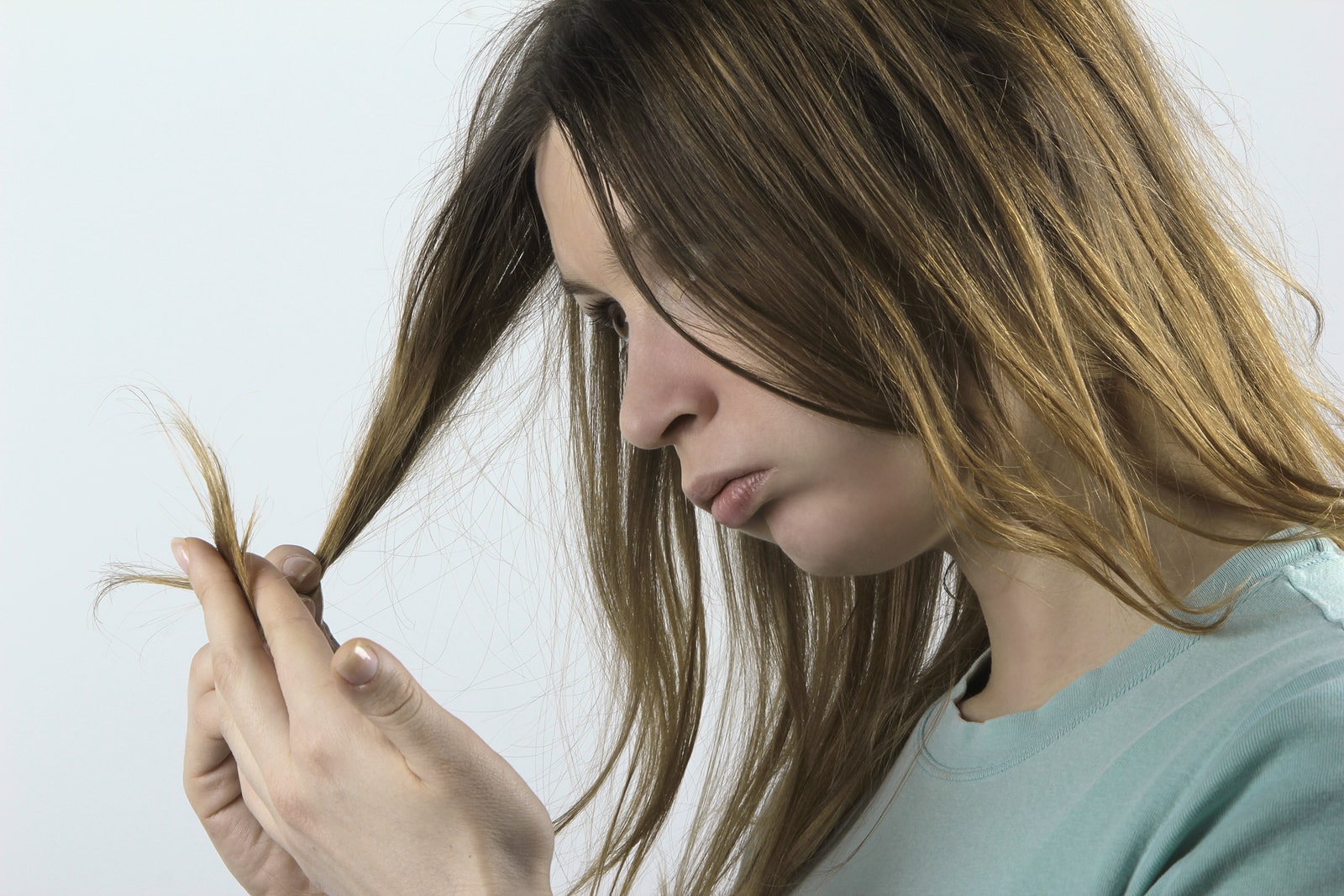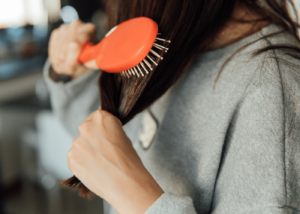Repairing damaged hair can feel like a daunting task. Things like regular color treatment, using shampoo with sulfates, or certain illnesses can cause hair to become brittle or damaged. Fortunately, there are lots of things you can do to repair your damaged hair and encourage healthy new growth. Read on for ten tips for repairing damaged hair.
1. Get a haircut
Split ends are a major source of hair damage. They occur when the shaft of the hair splits into two or more segments, usually at the tip, and cause the hair to continue to split further and further up the shaft all the way to the root. Split ends make already damaged hair even more brittle and susceptible to breakage and make the hair look weathered and dull. They even have long-term effects in that they inhibit the hair from growing evenly and efficiently. Common causes of split ends include:
- Overexposure to sunlight, seawater and chlorine
- Excessive use of heat tools
- Hair treatments and chemical exposure
- Hair ties and accessories
The best way to prevent split end damage is by keeping up with regular haircuts and trims. Hair grows about half an inch per month, meaning that throughout the year your hair will grow about 6 inches. However, everybody is different, and some people’s hair grows faster than others. Generally, if you have short hair, you should get a haircut every 4-6 weeks. People with medium and long hair should aim for every 6-8 weeks. It’s best to consult directly with your hairdresser regarding your specific haircut needs.
2. Try a deep conditioner or hair mask
Just like the rest of the body, hair requires high levels of concentrated hydration. Conditioners and hair masks that are rich in vitamins, oils, and naturally-sourced ingredients help hair maintain healthy hydration, which in turn encourages growth and helps hair stay shiny. There are lots of different types of hair treatments available based on hair type. For example, if you have color-treated hair, it is best to choose a product specifically formulated for it. It is important to try to work a treatment into your regular routine and use it at least twice per week for repairing damaged hair. Leave-in conditioners are also a great choice for maintaining hydrated hair around the clock.
3. Avoid heat tools
Lots of people utilize heating tools, such as blow driers, curling irons, and straighteners, in their daily routines. However, they can actually cause serious damage by drying out hair. Heat stresses the cuticle, causing the smooth coating that sits on the hair shaft to become rough and break off. Blow drying can cause color fade, split ends, and breakage. This is especially true with a lot of use over time. Letting hair dry naturally after washing is an easy way to reduce damage and allow your hair to retain more moisture. You can also use a heat-protectant serum before you do use heating tools and partially dry hair with a cotton T-shirt before styling. Lower the temperature on your tools if you can’t skip using them all together.
4. Protect your hair in the sun
UVA and UVB rays can damage the hair cuticle and cause thinning and frizzness. Sun-damaged hair looks and feels dry and is unable to hold curl or style. All hair types are susceptible to sun damage. Finer, lighter hair, however, lacks the pigment that can safeguard it from the sun’s rays, while dark, coarse hair is usually oilier, which provides somewhat more protection. You can take some of the following precautions to defend your hair against sun damage:
- Wear a scarf over your hair
- Take a wide-brimmed hat to the beach
- Use an umbrella in the sun
- Wear a swim cap at the pool
- Use SPF hair products
5. Change your shampoo
Changing the products you use to wash your hair can make a big difference in repairing damaged hair. Shampoo is designed to remove buildup of product and oils on the scalp. As it cleans your hair, it also strips the natural oils your hair needs to be healthy. Using less shampoo can help prevent over-stripping moisture, but you should also consider switching to a shampoo that does not contain harsh ingredients. There are lots of different shampoos available based on hair type that are formulated to strengthen and rehydrate hair.
Sulfate-free products
Sulfates are a type of surfactant that attract oil and water. They allow grime and dead skin cells to be removed from your scalp and washed away with water. Unfortunately, they take healthy oils with them, often leaving the hair dry and brittle. They can even cause scalp redness and dryness. The following sulfate compounds are frequently found in shampoo:
- Sodium laureth sulfate
- Sodium lauryl sulfate
- Ammonium laureth sulfate
While sulfates are perfectly safe to use, there are more and more sulfate-free products available that are gentler and less drying on hair. If you have frizzy or curly hair, sulfate-free shampoo can make your hair more manageable. Sulfate-free shampoo is also a good choice if you have color-treated hair, as sulfates can cause color to fade more quickly.
6. Try washing less frequently
Since shampoos are, by nature, drying, shampooing less often can help hair maintain its natural oils. The scalp produces more natural oils than the other parts of the body. These oils are distributed to each hair, which keep them healthy and soft. While it may seem daunting, it is actually better for your hair if you wait a day or two between washes. A simple rinse should do the trick when it comes to flushing away excess oil and product while allowing your hair to absorb the nourishing benefits of natural oil production. Washing the hair less often helps the scalp remain healthy. There is no one-size-fits-all answer for how often you should shampoo your hair. Some people have oily scalps and need to wash more frequently. You can use a dry shampoo between washes if your hair starts to feel oily.
7. Add layers
Asking your hairstylist to cut layers into your hair has a multitude of benefits. A fresh cut that removes the split ends or thins out excessively thick hair can help tremendously with repairing damaged hair. Layers can also make hair more manageable overall. Sometimes starting fresh is the best way to go, especially if the damage is severe, so consider mixing up your hairstyle and focusing on maintaining the overall health of new hair growth.
8. Invest in better tools
Depending on your daily habits, you might actually be damaging your hair through something as simple as using the wrong brush. Consider changing up the following tools if you’re noticing poor hair health:
- Hairbrush – There are many different types of hairbrushes that are more suitable for different hair types and situations. A wide-toothed comb is best for wet hair, which is very porous and susceptible to breakage. A boar-bristle brush won’t pull and tug on breakable strands and is a good choice for damaged hair for its oil distribution.
- Hair towel – A standard terrycloth towel might be too abrasive for drying your hair. The coarse texture can actually cause split ends and small craters along the shaft, weakening the hair and encouraging frizz. Swap out your towel for a T-shirt or microfiber towel for a more gentler drying solution.
9. Take a break from color treatments
Lots of people color treat their hair. In fact in 2020, 1.06 million Americans used hair coloring products 14 times or more. Unfortunately, hair dye is a major culprit when it comes to serious damage. In order for color to deposit onto the hair, the dye has to be able to get into the hair shaft, which means it has to move beyond the cuticle. To penetrate beyond the cuticle dye uses ammonia to elevate the pH of the hair and relax and lift the cuticle. The dye then uses peroxide to break down natural hair pigment. Peroxide is extremely drying to hair and can cause it to take on a straw-like texture. As the peroxide developer sits on the hair the cuticle remains lifted, weakening all the while. If you dye your hair regularly, the prospect of skipping treatments may seem unappealing. However, giving your hair a break now and then can make a big difference in the overall health and quality of your hair in the long run.
10. Change up your diet
Hair health is influenced greatly by diet. Try incorporating the following foods into your diet if you’ve noticed your locks are looking dull and limp:
- Pumpkin seeds
- Avocado
- Eggs
- Salmon
- Herring
- Mackerel
- Berries
- Sweet potatoes
- Spinach
- Soybeans
Contact us
For hair restoration solutions or to speak with a hair health professional in the Baltimore area, call Eldorado at 410-709-6627. You can also fill out a quick form and someone will contact you as soon as possible.




